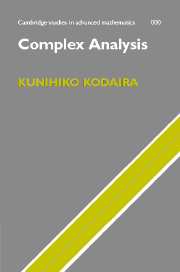7 - The structure of Riemann surfaces
Published online by Cambridge University Press: 05 June 2012
Summary
Planar Riemann surfaces
a. Planar Riemann surfaces
Let ℛ be a Riemann surface: by definition, ℛ is a connected Hausdorff space.
Theorem 7.1. Let C be a piecewise smooth Jordan curve on ℛ. Then ℛ − C is either one region or the disjoint union of two regions.
Proof: Let u = {Uj}, Uj = Ur(j)(qj) be the locally finite open covering of (6.59). By (6.61), U(C) = ∪qj∈cUj is a region containing C and C divides U(C) into two regions U+(C), to the left of C, and U−(C), to the right of C. If W is a connected component of the open set ℛ − C, then W has at least one boundary point, (because if W = [W], then ℛ could be written as the disjoint union of the open sets W and ℛ − W, contradicting the connectedness of ℛ). Since the boundary points of W are on C, W ∩ U(C) ≠ ∅, hence at least one of W ∩ U+(C) and W ∩ U−(C) is not empty. Suppose W ∩ U+(C) ≠ ∅; then U+(C) ⊂ W since U+(C) ⊂ ℛ − C and U is connected. Similarly, if W ∩ U−(C) ≠ ∅, then U−1(C) ⊂ W. Hence there are only three possibilities:
(1) U+(C) ⊂ W, U−(C) ⊂ W,
(2) U+(C) ⊂ W, W ∩ U−(C) = ∅,
(3) U−(C) ⊂ W, W ∩ U+(C) = ∅.
- Type
- Chapter
- Information
- Complex Analysis , pp. 319 - 375Publisher: Cambridge University PressPrint publication year: 2007

